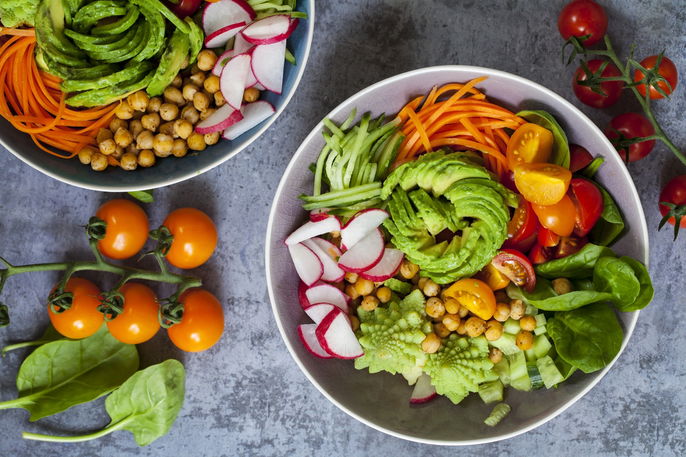A raw food diet is a type of diet made up of mainly raw and unprocessed plant-based sources, like fruits, vegetables, grains and legumes. Some people will cook these foods to a maximum temperature of 48ºC or 118.4ºF.
The possible benefits of a raw food diet are keeping you fuller for longer, promoting weight loss, preventing premature aging, reducing LDL cholesterol levels and combating constipation. This type of diet is rich in fiber, antioxidants and vitamins, and is also low in sugar and fats.
Before starting a raw food diet, you should consult a registered dietitian, as this diet is contraindication for some people, such as pregnant or breastfeeding women and patients with a compromised immune system from conditions like HIV, lupus and cancer.

How to start
A raw food diet is made-up of mainly fresh and raw foods, such as fruits, vegetables, tubers, seeds, nuts, mushrooms, legumes, lentils, beans and grains. These can also be juiced or consumed in dehydrated forms.
Some raw foods can also be heated to a maximum temperature of 48 ºC, like eggs, fish, poultry, beef, and unpasteurized dairy products.
What to eat
The foods allowed in a raw food diet are:
- Raw fruits, such as apples, oranges, avocados, mangos, bananas, pears, grapes, cherries and papaya
- Raw vegetables, such as cauliflower, lettuce, tomatoes, carrots, beets, spinach, radishes and kale
- Sprouted legumes, such as beans, chickpeas, lentils and soybeans
- Raw nuts, such as walnuts, almonds, cashews, Brazil nuts and hazelnuts
- Raw seeds, such as flaxseed, chia, sesame, sunflower and pumpkin
- Plant-based milks, made from hazelnut, rice, oat and coconut
- Cold-pressed vegetable oils such as olive oil, flaxseed oil, avocado oil, and coconut oil
With a raw food diet, you can also eat raw and unprocessed unpasteurized dairy products, such eggs, as well as fish, beef and chicken.
3-day meal plan
The following table outlines a sample of how to organize your meals for 3 days:
The types and quantities of food consumed in a raw food diet can vary depending on each person's personal preferences and nutritional needs. Therefore, you are advised to consult a registered dietitian for a complete assessment and a customized meal plan.
Foods to avoid
When maintaining raw food diet, you should avoid the following foods:
- Cooked fruits, vegetables, legumes, and grains
- Cooked beef, eggs, chicken and fish
- Roasted seeds and nuts
- Refined vegetable oils
- Coffees and teas
- Pasteurized and processed dairy products
You should also avoid consuming ultra-processed foods, such as ice cream, processed meats, refined sugar, cakes and cookies.
Difference between fruitarianism and a raw food diet
Fruitarianism is a type of diet that consists of mainly eating raw fruits, seeds and nuts.
With a raw food diet, you can also consume raw legumes, grains, eggs, fish, raw poultry, raw meat, and unpasteurized dairy products.
Health benefits
The main benefits of a raw food diet are:
- Reducing LDL cholesterol, due to low intake of sugar, ultra-processed foods and fats
- Promoting weight loss, as it is rich in fiber and keeps you fuller for longer
- Preventing premature aging, as it has great amounts of bioactive antioxidant compounds
- Combating constipation, as it is rich in fibers that stimulate natural bowel movements
However, there are still no scientific studies that support that a raw food diet is healthier than cooked food diet. Some nutrients and bioactive compounds, like proteins, carotenoids and starches, are actually better digested and absorbed in the gut after cooking them.
Possible risks
The main health risk of a raw food diet is food poisoning, as raw foods, like unpasteurized milk, raw meats and eggs, can be contaminated with bacteria such as Escherichia Coli, salmonella and listeria.
Some raw foods, like legumes, are also high in tannins and phytates, which are compounds that interfere with the digestion and absorption of some nutrients. This can potentially lead to deficiencies.
Contraindications for this diet
A raw food diet is not recommended for people who are at a higher risk for contracting food-borne illnesses, such as pregnant or breastfeeding women, older adults, children and people with a compromised immune system from conditions like HIV, diabetes, cancer and lupus.
Furthermore, a raw food diet is also not recommended for people with gastrointestinal problems such as diverticulitis, gastritis and ulcers, as raw fruits and vegetables are more difficult to digest and can cause discomfort, excess gas and abdominal pain.
Raw food diet recipes
Some healthy and tasty recipes that can be included in a raw food diet are:
1. Creamy banana smoothie
Ingredients:
- 2 frozen bananas
- 1 tablespoon of honey
- 50 ml of water
Directions
Keeping the peel on, wash and chop the banana. Place all the ingredients in the blender and mix until cream. Serve while cold.
2. Zucchini noodles with white sauce
Ingredients:
- 1 zucchini
- 2 cloves of garlic
- 240 ml of coconut milk
- 4 basil leaves
- Salt and black pepper to taste
Directions:
Wash and grate the zucchini. Peel and crush the garlic cloves and mix them with the coconut milk. Season the sauce with salt and black pepper, add the basil and pour over the zucchini.
3. Mango mousse
Ingredients:
- 2 large, very ripe mangos
- frozen coconut milk
- 2 tablespoons of honey
- 1 teaspoon of chia seeds
- 2 mint leaves
Directions:
Wash, peel and remove the core from the mangos. Mix all ingredients in a blender and serve while still cold.






























